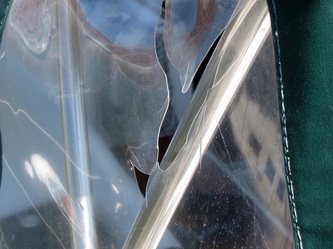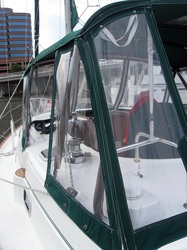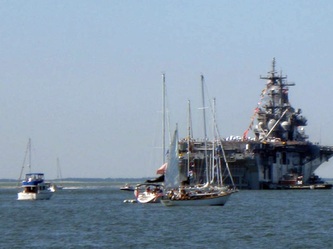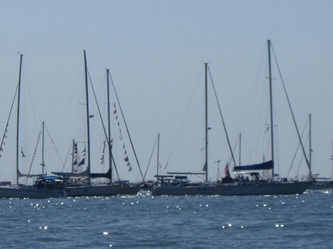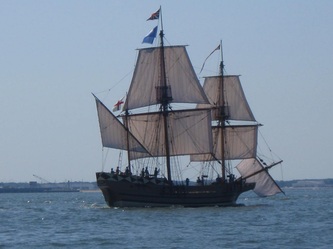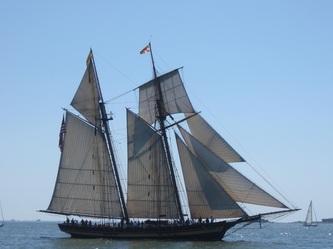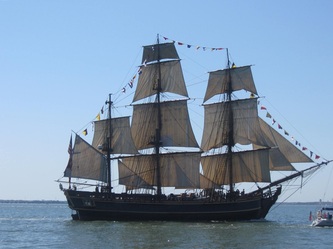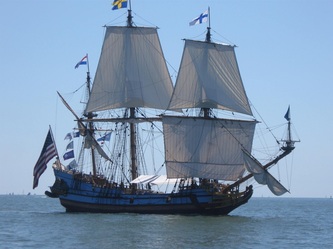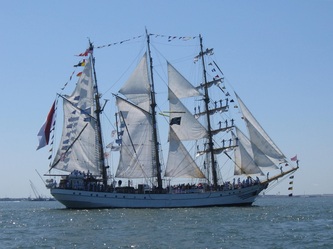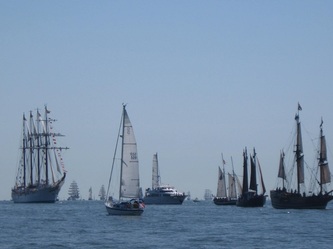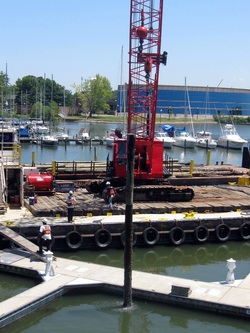
The Hampton Public Piers make repairs after the tornado.
We started June with a tornado and ended it with a violent thunderstorm that brought 70 knot winds through downtown Hampton. And it’s only June. Isn’t the worst summer weather due in July and August? At any rate, when we’re not dodging storms, we’re spending our time getting some technical upgrades done. We’ve bought a new PC and have finally left the cell phone dark ages and bought a smart phone.

Dave shows Steve a new app on his smart phone
Crossing the Technical Divide
Staying connected on the boat is something that makes our travels possible. Knowing we can contact family, check e-mail, monitor our bank accounts, and update the website lets us travel to remote places without worrying that we are too out of touch. With this in mind, before we started cruising, we chose a cell phone carrier that had the most coverage even in remote places. Also, our carrier had a data plan that allowed us to use our cell phone tethered to the PC as a modem, consuming only minutes to make the connection, with no additional airtime fees. So, with our cell phones, a laptop capable of picking up WiFi signals as well as a USB port to accept the cell phone tether, we were usually in good shape, able to stay connected in some remote places.
However, technology doesn’t stand still.
Not long after we started cruising, our wireless carrier stopped offering the data plan that we were using. We were told that if we changed phones, we would lose the plan. In researching alternatives, we were less than thrilled with the incredible expense of the data plans, so we have been simply been replacing our older model phone with reconditioned ones from eBay for the past 6 years, ensuring that we have a secure connection to the internet for sensitive transactions and harbors without WiFi. But we knew we were on borrowed time. Each time we upgraded our computer, we held our breath that the connection would still work. When our current laptop started showing signs that its time had passed (the touchpad mouse failed; USB ports were unreliable), its replacement arrived with the latest Windows 7 operating system. After several attempts to install the cell phone modem software on the new computer and despite long conversations with technical support, we came to the conclusion that we needed to find another way to connect.
Enter the smart phone.
We decided to upgrade to 2 new phones: one smart phone to provide our internet connection and one more traditional flip phone. We found Straight Talk offered the best deal. We opted for an unlimited plan for the smart phone and a 1000 minutes and text messages per month for the flip phone. This would give us a secure connection to the internet via the smart phone when we needed it. Dave has been immersing himself in the apps available for the phone and managed to limit himself to a manageable few that provide services we thought were essential. It quickly became apparent that managing the internal memory on the phone was critical. Some of the apps he chose are listed below:
Phone operation
Marine applications
Fixing Up
Staying connected on the boat is something that makes our travels possible. Knowing we can contact family, check e-mail, monitor our bank accounts, and update the website lets us travel to remote places without worrying that we are too out of touch. With this in mind, before we started cruising, we chose a cell phone carrier that had the most coverage even in remote places. Also, our carrier had a data plan that allowed us to use our cell phone tethered to the PC as a modem, consuming only minutes to make the connection, with no additional airtime fees. So, with our cell phones, a laptop capable of picking up WiFi signals as well as a USB port to accept the cell phone tether, we were usually in good shape, able to stay connected in some remote places.
However, technology doesn’t stand still.
Not long after we started cruising, our wireless carrier stopped offering the data plan that we were using. We were told that if we changed phones, we would lose the plan. In researching alternatives, we were less than thrilled with the incredible expense of the data plans, so we have been simply been replacing our older model phone with reconditioned ones from eBay for the past 6 years, ensuring that we have a secure connection to the internet for sensitive transactions and harbors without WiFi. But we knew we were on borrowed time. Each time we upgraded our computer, we held our breath that the connection would still work. When our current laptop started showing signs that its time had passed (the touchpad mouse failed; USB ports were unreliable), its replacement arrived with the latest Windows 7 operating system. After several attempts to install the cell phone modem software on the new computer and despite long conversations with technical support, we came to the conclusion that we needed to find another way to connect.
Enter the smart phone.
We decided to upgrade to 2 new phones: one smart phone to provide our internet connection and one more traditional flip phone. We found Straight Talk offered the best deal. We opted for an unlimited plan for the smart phone and a 1000 minutes and text messages per month for the flip phone. This would give us a secure connection to the internet via the smart phone when we needed it. Dave has been immersing himself in the apps available for the phone and managed to limit himself to a manageable few that provide services we thought were essential. It quickly became apparent that managing the internal memory on the phone was critical. Some of the apps he chose are listed below:
Phone operation
- Lookout – provides virus protection, in addition to allowing you to locate your phone using its GPS and emit a “scream” to make it easy to find.
- Onavo Count / Monitor Data – keeps track of usage to monitor the space available in memory and to show minutes and data usage
- Toggle Settings/Profile Lite – allows us to establish a rule that enables different profiles if the phone is charging, not charging, “nighttime”, etc. This is valuable in managing battery life, which will be important when we are underway.
Marine applications
- Marine Navigator Lite – acts as a back-up for our chartplotter, showing our position in real-time on downloaded raster charts, showing speed and course over ground.
- The Weather Channel – gets weather forecasts and issues severe weather alerts to phone
- Marine Weather – provides access to marine forecasts and live buoy data
- Marine Traffic – AIS data (ship’s names, positions, course, speed) on marine charts
- NOAA Smart Buoys - provides live data from NOAA Chesapeake Bay buoys, giving current conditions
Fixing Up
After the tornado, Cathy got our her sewing machine to re-attach zippers on the bimini and fix the enclosure panel. She managed to purchase a strataglass scrap at a nearby canvas shop and then carefully fitted it over the damaged glass. After sewing the sunbrella back in place over both layers, she cut away the damaged glass and the repaired panel was ready to re-hang.
Dave put his efforts into waxing the hull. This is a little tricky when the boat is in the water. Using a raft available for this purpose in the marina, Dave worked his way around the boat, managing to use one hand to keep him steady and close to the boat and the other to apply and remove the wax.
Cathy was able to make a long-delayed repair to replace a portlight “key” that had broken on the portlight above the stove in the galley. After purchasing a replacement kit from West Marine, it was a simple job to pop off the plug over the screw, unscrew the old one, screw in the new one and pop the new plug in place. It looks great.
Finally, we extended the life of our camera, a Canon Powershot A590 that had been giving us false “low battery” signals frequently enough that we started looking to replace it. In the process, Cathy learned of a simple fix to the battery sensor. After making the simple adjustment, the false “low battery” messages stopped appearing.
Dave put his efforts into waxing the hull. This is a little tricky when the boat is in the water. Using a raft available for this purpose in the marina, Dave worked his way around the boat, managing to use one hand to keep him steady and close to the boat and the other to apply and remove the wax.
Cathy was able to make a long-delayed repair to replace a portlight “key” that had broken on the portlight above the stove in the galley. After purchasing a replacement kit from West Marine, it was a simple job to pop off the plug over the screw, unscrew the old one, screw in the new one and pop the new plug in place. It looks great.
Finally, we extended the life of our camera, a Canon Powershot A590 that had been giving us false “low battery” signals frequently enough that we started looking to replace it. In the process, Cathy learned of a simple fix to the battery sensor. After making the simple adjustment, the false “low battery” messages stopped appearing.

Columbia's tall ship, Gloria, joins OpSail
Sailing the Harbor
We were lucky to be in Hampton for the arrival of OpSail 2012 Virginia, a year-long celebration of the 200th anniversary of the War of 1812, which brought together a fleet of tall ships to the Hampton Roads harbor. The day of the official opening, we took a ride out on Steve’s boat, Bay Dreamer, to watch the parade of ships entering the harbor. It was a picture-perfect day, and hundreds of boats were in the harbor to watch the ships arrive.
We were lucky to be in Hampton for the arrival of OpSail 2012 Virginia, a year-long celebration of the 200th anniversary of the War of 1812, which brought together a fleet of tall ships to the Hampton Roads harbor. The day of the official opening, we took a ride out on Steve’s boat, Bay Dreamer, to watch the parade of ships entering the harbor. It was a picture-perfect day, and hundreds of boats were in the harbor to watch the ships arrive.
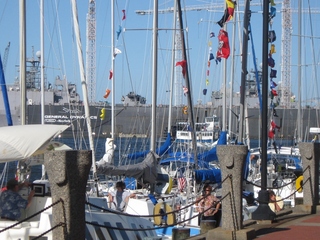
Boats docked at Portsmouth for the Cock Island race
A couple of weeks later, on an unusually blustery Friday afternoon, Dave joined Steve on a sail over to Portsmouth to reposition Bay Dreamer for the 25th annual Cock Island Race. It was a fast downwind sail on a furled headsail, and an exciting docking, as Steve had to raft to a line of boats in the crowded Portsmouth basin north of the Renaissance Hotel with winds gusting to 25 knots. Afterward, we joined him for the “before race” party. On Sunday, Dave joined Steve for a calmer sail back to Hampton.
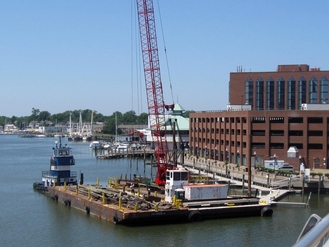
A crane replaces pilings at the Public piers
Hampton Fixes Up
The repairs have been on-going since the tornado came through on the 1st of June. Not too long afterward, a barge with a crane appeared to make repairs to the roofless Amory Seafood and install a myriad of new pilings to the docks along the river. We watched it work on the public piers as it fixed the pilings right across from us.
The repairs have been on-going since the tornado came through on the 1st of June. Not too long afterward, a barge with a crane appeared to make repairs to the roofless Amory Seafood and install a myriad of new pilings to the docks along the river. We watched it work on the public piers as it fixed the pilings right across from us.
